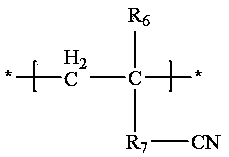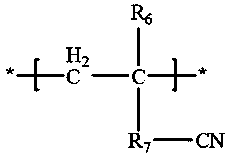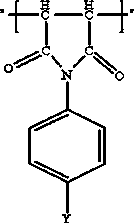UV-resistant ink positive image UV-CTP lithographic printing plate
A UV-CTP, lithographic printing plate technology, applied in the direction of printing, printing process, pattern surface photoplate making process, etc., can solve the problem of poor solvent resistance and printing resistance, large developing latitude, good solvent resistance, etc. problems, to achieve the effects of strong printing resistance, large developing latitude, and high film retention rate of alkali resistance
- Summary
- Abstract
- Description
- Claims
- Application Information
AI Technical Summary
Problems solved by technology
Method used
Image
Examples
Embodiment 1
[0043] Example 1 (emulsion particles 01)
[0044] Add 250 g of isopropanol, 150 g of deionized water, 24 g of N, N-dimethylformamide, 34 g of methyl acrylate, and 5 g of dioctylsuccinate into a 1000 ml three-necked flask equipped with a stirrer, a reflux tube, and a dropping funnel. Acid sodium, 1 g AIBN (azobisisobutyronitrile), stir well, and use a hot water bath to heat to 80 ° C, dropwise add 27 g of acrylonitrile, 5 g of methacrylic acid, 0.5 g of AIBN (azobisisobutyronitrile ) was dissolved in 150g isopropanol to form a mixed solution, added dropwise in 1 hour, reacted for 1 hour, then added dropwise 10g N-(4-sulfonamidobenzene) maleimide, 0.5g AIBN (azobis Isobutyronitrile) is dissolved in the mixed solution that 100g Virahol forms, and 1 hour dropwise is completed. The reaction was completed after 10 hours at a constant temperature, and emulsion particles 01 were obtained.
[0045] The solid content is 18.3%, the weight average molecular weight is 25000, and the numb...
Embodiment 2
[0046] Example 2 (emulsion particles 02)
[0047] Add 250 g of isopropanol, 150 g of deionized water, 15 g of N,N-dimethylformamide, 20 g of methyl acrylate, and 5 g of dioctylsuccinate into a 1000 ml three-necked flask equipped with a stirrer, a reflux tube, and a dropping funnel. Acid sodium, 1.2 g AIBN (azobisisobutyronitrile), stir evenly, and use a hot water bath to heat to 80 ° C, dropwise add 31 g of N-(4-sulfonamidobenzene) maleimide, 30 g of 3- Acrylonitrile, 4 g of methacrylic acid, 0.8 g of AIBN (azobisisobutyronitrile) were dissolved in a mixed solution of 250 g of isopropanol, and the addition was completed dropwise in 1.5 hours. After 9 hours of reaction at constant temperature, the emulsion particles 02 were obtained.
[0048] The solid content is 16.1%, the weight average molecular weight is 32000, and the number average molecular weight is 2300.
Embodiment 3
[0049] Example 3 (emulsion particles 03)
[0050] In a 1000ml three-necked flask equipped with a stirrer, a reflux tube, and a dropping funnel, add 250 g of isopropanol, 150 g of deionized water, 30 g of N-(4-hydroxybenzene) methacrylamide, 10 g of methyl acrylate, 5 g Dioctyl sodium succinate, 1.2 g AIBN (azobisisobutyronitrile), stir evenly, and use a hot water bath to heat to 80 ° C, dropwise add 25 g N-(4-acetoxyphenyl) maleimide Amine, 30g of acrylonitrile, 5g of methacrylic acid, and 0.8g of AIBN (azobisisobutyronitrile) were dissolved in a mixed solution of 250g of isopropanol, and the addition was completed dropwise in 2 hours. After 10 hours of reaction at constant temperature, the emulsion particle 03 was obtained.
[0051] The solid content is 14.2%, the weight average molecular weight is 30000, and the number average molecular weight is 2100.
PUM
 Login to view more
Login to view more Abstract
Description
Claims
Application Information
 Login to view more
Login to view more - R&D Engineer
- R&D Manager
- IP Professional
- Industry Leading Data Capabilities
- Powerful AI technology
- Patent DNA Extraction
Browse by: Latest US Patents, China's latest patents, Technical Efficacy Thesaurus, Application Domain, Technology Topic.
© 2024 PatSnap. All rights reserved.Legal|Privacy policy|Modern Slavery Act Transparency Statement|Sitemap



